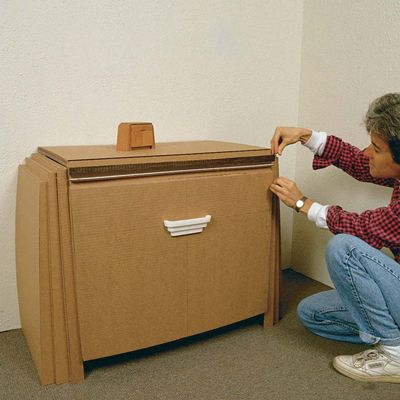Models Help Projects Succeed
Prototypes of cardboard, foam or paper help solve design and construction problems
Synopsis: Whether prototypes are cardboard or foam, full size or one-eighth scale, they help solve a long list of furnituremaking problems, writes Jan Zaitlin. Clients love them, and she finds them worthwhile in making her own furniture. Zaitlin explains how to build a quick mock-up, a full-scale mock-up, and a full-size detail mock-up. She talks about the applications and the materials for each, too. Side information talks about how to set up photos that make the models look real.
I’m a big fan of making models and mock-ups before I move on to a finished piece of furniture. Whether the prototypes are cardboard or foam, full size or one-eighth scale, they help solve a long list of furnituremaking problems. Models are good for demonstrating knockdown features and can help me decide what construction techniques to use. Clients love models because visualizing the real thing from drawings can be difficult; models can show clients how finished pieces will look in their intended room settings. Even if I’m building a project for myself, a quick model can prevent disappointments later.
I use several types of models, and the applications and the materials for each vary. I have three favorites: the quick, full-scale mock-up, what I call the scale appearance model, and the full-size detail mock-up like the one in the photo above.
A quick, full-scale mock-up
A mock-up is a quick, inexpensive, full-scale, approximation of the completed piece. The purpose is to catch any obvious mistakes in proportion. I usually build one right after I have my design concept drawn, dimensioned and approved. The mock-up shouldn’t take more than an hour to construct and should be taken to the site. There, I can tell if the finished piece will be the right size for the intended space, if it blocks too much light or if its position or dimensions will cause some other unexpected problem, such as limiting the swing of a door. If the project is a dining table, I can place chairs around the mock-up to see if it makes the room seem too crowded, allows room for serving platters and seats the required number of people comfortably.
I use inexpensive materials that can be worked quickly. Mockups need not be pretty. For most projects, I use corrugated cardboard, which can be used for curved as well as angular projects because I can bend it with the “grain.” And I can draw on it with a pencil or marker to suggest details.
Sometimes the appropriate mock-up material is foam board, polystyrene foam sandwiched between smooth paper. Foam board looks cleaner than cardboard, and it doesn’t have the strong grain that corrugated cardboard has. It is available at art and architectural supply stores and comes in a range of thicknesses (1 ⁄8 in., 3 ⁄16 in., 1 ⁄2 in.) and in sheet sizes up to 4 ft. by 8 ft.
From Fine Woodworking #111
For the full article, download the PDF below:
Fine Woodworking Recommended Products

Sketchup Class

Circle Guide

Drafting Tools






















Log in or create an account to post a comment.
Sign up Log in